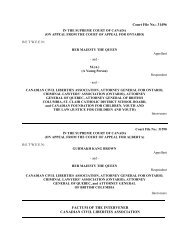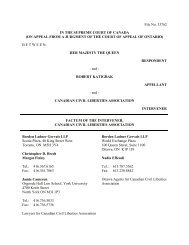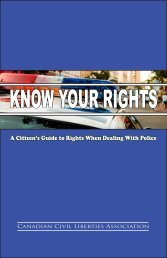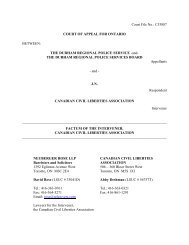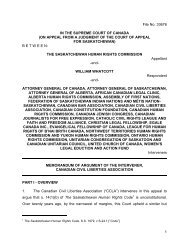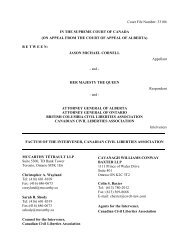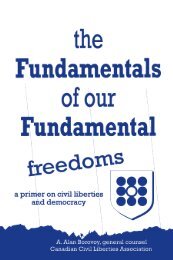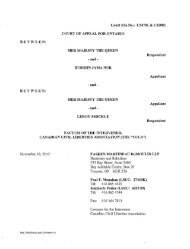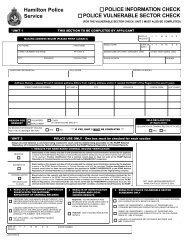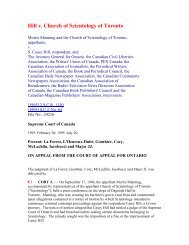Factum Shell with appropriate styles - Canadian Civil Liberties ...
Factum Shell with appropriate styles - Canadian Civil Liberties ...
Factum Shell with appropriate styles - Canadian Civil Liberties ...
You also want an ePaper? Increase the reach of your titles
YUMPU automatically turns print PDFs into web optimized ePapers that Google loves.
Court File No. 33089IN THE SUPREME COURT OF CANADA(ON APPEAL FROM THE COURT OF APPEAL FOR BRITISH COLUMBIA)B E T W E E N:AND B E T W E E N:CITY OF VANCOUVERandALAN CAMERON WARDAppellantRespondentHER MAJESTY THE QUEEN IN RIGHT OF THE PROVINCE OF BRITISH COLUMBIAandALAN CAMERON WARDandAppellantRespondentATTORNEY GENERAL OF CANADA, ATTORNEY GENERAL OF ONTARIO andATTORNEY GENERAL OF QUEBECIntervenersFACTUM OF THE INTERVENERCANADIAN CIVIL LIBERTIES ASSOCIATION
PART I – OVERVIEW OF THE CCLA’S POSITION1. The Charter does more than entrench fundamental rights and freedoms. It also institutesa remedial regime designed to ensure that those rights and freedoms are protected againstencroachment. Section 24(1) is the cornerstone of that remedial regime.2. Section 24(1) must be interpreted broadly, in accordance <strong>with</strong> its language and purpose.In its prior cases addressing s. 24(1), this Court has held that courts exercising remedialdiscretion under s. 24(1) must be free to craft innovative and flexible remedies that willmeaningfully vindicate Charter rights that have been breached. This Court has also recognizedthat the imposition of rigid rules or general constraints on the remedial authority granted under s.24(1) will impede courts‟ ability to craft “<strong>appropriate</strong> and just” remedies in particular cases. Therule proposed by the Appellants in this case would have precisely this effect, and should berejected.3. Remedies under section 24(1) are not merely compensatory, nor are they limited toredressing past wrongs. On the contrary, an award of non-compensatory damages may benecessary to vindicate a Charter right in a given case. Damages may be required, for example,to deter similar breaches in the future or to express disapproval of unconstitutional conduct.Even in cases where individuals may not have suffered a compensable loss, courts should be freeto craft a remedy that redresses the loss of dignity or moral harm associated <strong>with</strong> a Charterbreach.4. While the common law may provide useful points of reference to a court engaged infashioning a constitutional remedy, private law requirements such as bad faith, abuse of power ortortious conduct do not and should not apply to remedies made under s. 24(1). The Charter isaimed at advancing societal purposes that go well beyond the more narrow considerations ofprivate law. Constitutional breaches not only harm the individuals whose rights are infringed,they also threaten to undermine the rule of law and the rights and freedoms that have beenguaranteed under the Charter. While proof of bad faith, abuse of power or tortious conduct maybe a prerequisite to an award of damages against the government in the context of a common lawclaim, remedies under s. 24(1) must address public, as well as private harms, and thereforecannot be subject to such limitations.
5. A remedy under s. 24(1) must, of course, be consistent <strong>with</strong> the proper role of the courts<strong>with</strong>in Canada‟s constitutional democracy. It is difficult to conceive of a remedy that is morefirmly established in the judicial domain than an award of damages. Courts have expertise in themaking of such awards. In doing so, courts do not intrude on legislative or executive functions.6. In the Mackin line of cases this Court has articulated certain prerequisites for the makingof damages awards in a case where an individual‟s rights have been infringed due to action takenunder a statute subsequently held to be unconstitutional. Those prerequisites do not apply tocases such as this, where the Charter breach was the direct product of government action againstan individual, and where there is no question of statutory invalidity.PART II – CCLA’S POSITION ON THE QUESTION IN ISSUE7. The CCLA submits that s. 24(1) of the Charter authorizes a court of competentjurisdiction to award damages, where <strong>appropriate</strong> based on the particular circumstances of agiven case, to any person whose Charter rights have been infringed, even when the Charterbreach does not result in loss to that person and was not the product of tortuous conduct, badfaith or an abuse of power on the part of the infringer.PART III – ARGUMENTSection 24(1) Must be Construed Broadly In Accordance With Its Language And Purpose8. Section 24(1) of the Charter is drafted in the broadest possible terms. Its language isboth expansive and permissive. Section 24(1) imposes no limits on the type of remedy that acourt may provide to a person whose Charter rights are infringed. Rather, it allows a court toaward any remedy that “the court considers <strong>appropriate</strong> and just in the circumstances”. As thisCourt has observed, “[i]t is difficult to imagine language which could give the court a wider andless fettered discretion.” 11<strong>Canadian</strong> Charter of Rights and Freedoms, s. 24(1), Part I of the Constitution Act, 1982, being Schedule B tothe Canada Act 1982, (U.K.) 1982, c. 11; Mills v. The Queen (“Mills”), [1986] 1 S.C.R. 863 at paras. 261, 276-278, 297, 298; R. v. 974649 Ontario Inc. c.o.b. as Dunedin Construction (“Dunedin”), [2001] 3 S.C.R. 575 atpara. 18.
9. Like the sections of the Charter that provide for underlying rights and freedoms, s. 24(1)must be interpreted generously and liberally, rather than in a narrow, technical or legalisticmanner. Section 24(1) must also be interpreted in a manner that advances its purpose, which isto vindicate fundamental rights and freedoms by providing “a full, effective and meaningfulremedy for Charter violations”. As Lamer J. (as he then was) wrote in his dissent in Mills,“[s]ection 24(1) establishes the right to a remedy as the foundation stone for the effectiveenforcement of Charter rights”. In order to ensure that the enforcement of Charter rights iseffective and responsive, courts must be free to exercise their remedial power under s. 24(1) in amanner that is flexible, creative, and tailored to the needs of the particular case before them. 210. Section 24(1) applies to all Charter rights and freedoms, not just to the rights at issue inthis appeal. Moreover, infringements of particular provisions of the Charter occur in widelydisparate factual circumstances. Accordingly, it is important that courts have the latitude tochoose from among the full range of potential remedies when adjudicating a case involving aconstitutional breach. Ultimately, whether a particular remedy is <strong>appropriate</strong> and just in thecircumstances is a determination that can only be made in the context of a given case, based oncareful consideration of the nature of the right or freedom that has been infringed, the nature ofthe infringement, and the facts of the case. 311. This Court has repeatedly rejected the imposition of any blanket rule that would constraina court‟s ability to fashion an <strong>appropriate</strong> and just remedy in a particular case. In Mills, theCourt held that “[it] is impossible to reduce this wide discretion to some sort of binding formulafor general application in all cases, and it is not for appellate courts to pre-empt or cut down thiswide discretion”. In R. v. Gamble, the Court “agree[d] <strong>with</strong> the general proposition…thatCharter relief should not be denied or „displaced by overly rigid rules‟”. In Osborne, the Courtnoted that “[b]y reason of the diverse and novel problems which it will be called upon to redress,the court must maintain at its disposition a variety of remedies as part of its arsenal”. In Doucet-23Mills, [1986] 1 S.C.R. at paras. 26-27, 265, 278, 303; Doucet-Boudreau v. Nova Scotia (Department ofEducation) (“Doucet-Boudreau”), [2003] 3 S.C.R. 3 at paras. 23-25, 54-59; Osborne v. Canada (“Osborne”),[1991] 2 S.C.R. 69 at para. 65; R. v. Rahey (“Rahey”), [1987] 1 S.C.R. 588 at paras. 102, 125; R. v. Gamble(“Gamble”), [1988] 2 S.C.R. 595 at paras. 66, 68; Dunedin, [2001] 3 S.C.R. at paras. 18-20, 74; Quebec(Commission des droits de la personne et des droits de la jeunesse) v. Cummunauté urbaine de Montréal,[2004] 1 S.C.R. 789 at para. 26Dunedin, [2001] 3 S.C.R. at para. 20, 74; Doucet-Boudreau, [2003] 3 S.C.R. at paras. 52, 59.
Boudreau, the Court concluded that “the judicial approach to remedies must remain flexible andresponsive to the needs of a given case” and that “[a] superior court may craft any remedy that itconsiders <strong>appropriate</strong> and just in the circumstances” (emphasis added). 412. Adopting the legal rule proposed by the Appellants in this case would impose exactly thetype of restriction on remedial power under s. 24(1) that this Court has disapproved in the casescited above. A general prohibition on damage awards in cases that do not involve bad faith, anabuse of power or tortious conduct – regardless of the right or freedom that has been infringed,the nature of the infringement, or the particular circumstances at issue in a given case – wouldrob the courts of an alternative that might be required to provide an <strong>appropriate</strong> and just remedyin a particular case. Such a rule would be inconsistent <strong>with</strong> the broad and permissive language ofs. 24(1) and contrary to this Court‟s prior decisions interpreting that provision.Damages May Be Necessary For Non-Compensatory Purposes13. In some cases, an award of damages may be necessary to provide an <strong>appropriate</strong> and justremedy for a Charter breach even where the person whose rights were breached did not suffer acompensable loss. Damages may be <strong>appropriate</strong>, for example, to deter other Charter breachesfrom occurring in the future. They may also provide a mechanism for registering disapproval ofa particular breach or emphasizing the importance of the right that has been breached. Further,damages may be awarded in recognition of the loss of dignity inherent in a Charter breach, evenwhere no pecuniary or traditional loss has been established.14. Decisions rendered in other Commonwealth jurisdictions have recognized that in certaincircumstances an award of non-compensatory damages may be required to vindicate a breach offundamental rights. In Attorney-General of Trinidad and Tobago v. Ramanoop, also a case ofpolice misconduct, the Privy Council concluded that it was “unable to accept the AttorneyGeneral‟s basic submission that a monetary award under section 14 [of the Constitution of theRepublic of Trinidad and Tobago] is confined to an award of compensatory damages in thetraditional sense”. The Privy Council reasoned as follows:4Mills, [1986] 1 S.C.R. at paras. 276-278, 309; Gamble, [1988] 2 S.C.R. at paras. 66, 67; Osborne, [1991] 2S.C.R. at para. 65; Doucet-Boudreau, [2003] 3 S.C.R. at paras. 59, 87.
An award of compensation will go some distance towardsvindicating the infringed constitutional right. How far it goes willdepend on the circumstances, but in principle it may well notsuffice. The fact that the right violated was a constitutional rightadds an extra dimension to the wrong. An additional award, notnecessarily of substantial size, may be needed to reflect the senseof public outrage, emphasize the importance of the constitutionalright and the gravity of the breach, and deter further breaches. Allof these elements have a place in the additional award. 515. In Merson v. Cartwright, a police misconduct case from the Bahamas, the Privy Councilmade clear that “vindicatory” damages may need to go further than what is necessary tocompensate a plaintiff for his or her loss:If the case is one for an award of damages by way of constitutionalredress … the nature of the damages award may be compensatorybut should always be vindicatory and, accordingly, the damagesmay, in an <strong>appropriate</strong> case, exceed a purely compensatoryamount. 6 (Emphasis added.)16. In Simpson v. Attorney-General (Baigent’s case), which involved an allegedlyunreasonable police search, the New Zealand Court of Appeal noted that deterrence and othernon-compensatory objectives are relevant when considering the quantum of damages to beawarded for a breach of fundamental rights:As to the level of compensation, on which again there is muchinternational case law, I think that it would be premature at thisstage to say more than that, in addition to any physical damage,intangible harm such as distress and injured feelings may becompensated for; the gravity of the breach and the need toemphasize the importance of the affirmed rights and to deterbreaches are also proper considerations; but extravagant awards areto be avoided. 7 (Emphasis added.)17. The non-compensatory considerations described above all flow directly from the meaningof the term “vindicate”. Vindicating a Charter right involves more than simply compensatingthe individual victim of the breach – it includes redressing the broader societal harm caused by567Attorney-General of Trinidad and Tobago v. Ramanoop, [2006] 1 A.C. 328 at paras. 19, 20 (Privy Council).Merson v. Cartwright, [2005] UKPC 38 at para. 18 (Privy Council).Simpson v. Attorney-General (Baigent’s case), [1994] 3 NZLR 667 at p. 678 (N.Z. Court of Appeal).
the breach. In Taunoa v. Attorney-General, the Supreme Court of New Zealand offered thefollowing observations on the public law element of vindication:One of the ordinary meanings which “to vindicate” bears … is “todefend against encroachment or interference”. [The OxfordEnglish Dictionary 2d ed vol XIX at 642.] Society has an interestin the defence that is required here. Violations of constitutionallyprotected rights harm not only their particular victims, but it as awhole too. That is so because, unless they are adequatelyremedied, they will impair public confidence and diminish publicfaith in the efficacy of the protection, and for a good reason toosince one invasion discounted may well lead to another.…The dual purpose of Bill of Rights remedies is reflected in the factthat when there is a breach of human rights there are two victims.First there is an immediate victim. The interests of that victimrequire the court to consider what, if any, compensation is due.But, because the breach also tends to undermine the rule of lawand societal norms, society as a whole becomes a victim too.Hence, the court must also consider what is necessary by way ofvindication in order to protect society‟s interests in the observanceof fundamental rights and freedoms. 818. In some cases, vindication may be attained by declaratory relief or by an award of purelycompensatory damages. In other cases, an award of non-compensatory damages – whether in amodest amount (as was done in this case) or in a more substantial amount – will be required tovindicate the right that has been breached.Section 24(1) Remedies Should Not Be Limited By Private Law Requirements19. While certain common law claims against government actors may require a plaintiff toestablish bad faith, abuse of power or compensable loss, those requirements do not and shouldnot restrict the remedies available under s. 24(1).20. Private law is primarily aimed at compensating individuals for harm suffered. As arguedabove, Charter remedies are concerned not only <strong>with</strong> redressing harm done to an individual butalso <strong>with</strong> the larger societal ramifications of a breach of fundamental rights and freedoms,8Taunoa v. Attorney-General, [2007] 1 NZLR 429 at paras. 253, 317, 366-367 (SCNZ).
including the need to maintain strong protections for those rights and freedoms and to preservethe integrity of the judicial system. Because the Charter protects both individual rights andbroader public interests, in fashioning remedies under s. 24(1) courts should not be constrainedby common law principles focused solely on private interests. 921. This Court has repeatedly held that remedies under s. 24(1) are distinct from traditionalcommon law remedies. In Rahey, La Forest J. described s. 24(1) as “an entirely novel proceduralmechanism” and stated that “[c]ourts, therefore, can no longer treat existing remedies as definingthe scope of the right”. 10In Gamble, which addressed the relationship between the traditionalwrit of habeas corpus and the relief accorded under s. 24(1), the Court adopted the followingview:[A] right of application conferred by s. 24(1) of the Charter is notto be cut down by limitations placed on the exercise ofdiscretionary powers or prerogative remedies in non-Chartersituations … nor will the vindication of Charter rights be subjectedto limitations not developed <strong>with</strong> Charter rights in mind. 1122. The Charter‟s remedial regime was intended to be flexible, as well as expansive. InO’Connor, this Court advised that “[i]t is important to recognize that the Charter has now putinto judge‟s hands a scalpel instead of an axe – a tool that may fashion, more carefully than ever,solutions taking into account the sometimes complementary and sometimes opposing concernsof fairness to the individual, societal interests, and the integrity of the judicial system”. 1223. While common law rules may provide useful guidance to a court fashioning a remedyunder s. 24(1), they cannot be used to limit the remedies available for a constitutional breach. InDoucet-Boudreau, the Court held that:The power of the superior courts under s. 24(1) to make<strong>appropriate</strong> and just orders to remedy infringements or denials ofCharter rights is part of the supreme law of Canada. It follows that9101112R. v. O’Connor (“O’Connor”), [1995] 4 S.C.R. 411 at paras. 61-65.Rahey, [1987] 1 S.C.R. at para. 102.Gamble, [1988] 2 S.C.R. at para. 64.O’Connor, [1995] 4 S.C.R. at para. 69.
this remedial power cannot be strictly limited by statutes or rulesof the common law. 1324. The enactment of the Charter gave rise to “a new regime of constitutional rights andremedies”. Section 24(1) was designed to provide courts <strong>with</strong> the power to fashion new – and ifnecessary novel – remedies to protect fundamental rights. If constitutional remedies were to berestricted by the imposition of private law requirements such as bad faith, abuse of power orcompensable loss, s. 24(1) would be rendered an empty vessel. The result would be that courtswould be left <strong>with</strong>out the means to address the broader societal aspects of Charter breaches. 14Making Awards of Damages Falls Within The Proper Role Of The Courts25. Courts fashioning remedies under s. 24(1) must act <strong>with</strong>in the framework of Canada‟sconstitutional democracy and refrain from straying into roles reserved to other branches ofgovernment. 1526. Damages are clearly an <strong>appropriate</strong> remedy for a court to award under s. 24(1).Determining whether to award damages, and setting the quantum of damages where such anaward is made, falls squarely <strong>with</strong>in the institutional competence and proper role of the courtsand does not in any way intrude upon the legislative or executive functions.Statutory Invalidity Cases Are Distinguishable And Do Not Apply Here27. Contrary to the Appellants‟ submissions, this Court‟s decision in Mackin v. NewBrunswick does not govern the outcome of this appeal. Mackin addressed the issue of whetherdamages are available when Charter rights are breached by government action taken pursuant toa valid statute only later held to be unconstitutional. In Mackin, this Court held that in such casesdamages are generally not available absent bad faith or abuse of power and that the properremedy is a declaration of invalidity under s. 52 of the Constitution Act, 1982. 1613141516Doucet-Boudreau, [2003] 3 S.C.R. at para. 51.Dunedin, [2001] 3 S.C.R. at para. 39; Doucet-Boudreau, [2003] 3 S.C.R. at paras. 59, 87.Osborne, [1991] 2 S.C.R. at para. 65; Dunedin, [2001] 3 S.C.R. at paras. 33-36, 56, 87, 106-110.Mackin v. New Brunswick (Minister of Finance) (“Mackin”), [2002] 1 S.C.R. 405 paras. 78-84.
28. This Court has been careful to limit the principle set out in Mackin to cases involving theenactment or application of an unconstitutional statute. The Mackin principle is grounded in thenotion of qualified immunity, under which government actors acting in good faith are entitled tofollow the prescriptions of a statute valid at the time of their action, even if that statute issubsequently found to be unconstitutional, <strong>with</strong>out exposure to damages. Moreover, in casesclaiming statutory invalidity, an alternative remedy – the striking out of the offending statute – isavailable to vindicate the right. 1729. Unlike Mackin and similar cases, this case involves direct government action in breach ofan individual‟s Charter rights. The police officers in question here were not acting pursuant to astatute later found to be unconstitutional. Rather, their actions constituted a breach of theRespondent‟s Charter rights at the time that those actions were taken. There is accordingly nopossibility of relief under s. 52 of the Constitution Act, 1982 in this case, nor is there anyquestion of qualified immunity. The remedies available under 24(1) are not – or should not be –subject to the same limitations raised in a case involving government action pursuant to a statuteonly later determined to be unconstitutional.Conclusion30. The remedial authority created under s. 24(1) is framed in the broadest of terms. Thoseterms allow courts to fashion imaginative remedies that vindicate Charter rights breached in awide variety of circumstances. In some cases, an award of non-compensatory damages may berequired to deter future breaches, to underline the importance of the right at issue, or to voicedisapproval of unconstitutional conduct. While courts can and should look to common lawprinciples for guidance in fashioning constitutional remedies, they cannot be constrained bythese principles. Remedies under s. 24(1) are not only concerned <strong>with</strong> redressing individualharm, but also <strong>with</strong> addressing the broader public harm caused by a Charter breach. Without theability to grant remedies not available as a matter of private law, courts would not be able to givemeaning to the rights and freedoms guaranteed under the Charter.17Mackin, [2002] 1 S.C.R. at paras. 78-82; Schachter v. Canada, [1992] S.C.R. 679 at p. 720; Guimond v. Quebec(Attorney General), [1996] 3 S.C.R. 347 at paras. 13, 14 and 19.
PART IV - COSTS31. The CCLA does not seek costs and asks that no costs award be made against it.PART V - ORDER SOUGHT32. The CCLA requests permission to present oral argument for 10 minutes at the hearing ofthe appeal.33. The CCLA asks that the constitutional question framed by the Chief Justice be answeredin the affirmative.ALL OF WHICH IS RESPECTFULLY SUBMITTEDStuart SvonkinJana StettnerCounsel for the <strong>Canadian</strong> <strong>Civil</strong> <strong>Liberties</strong> Association



